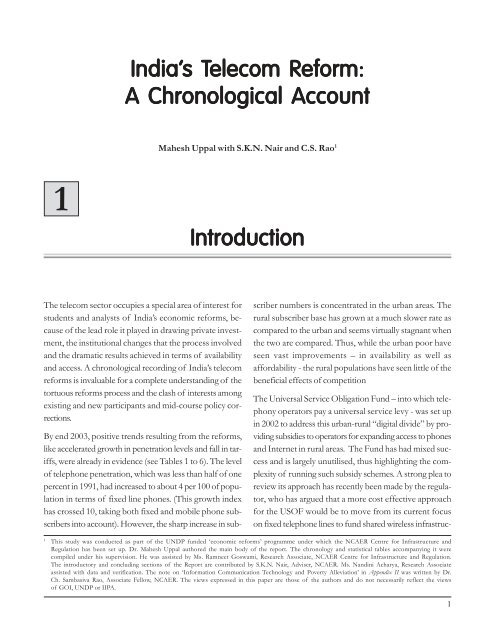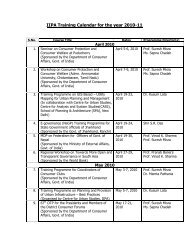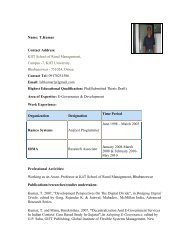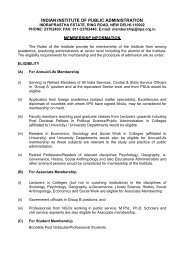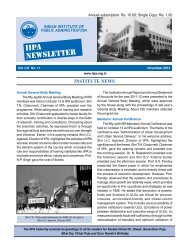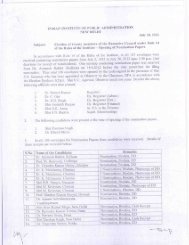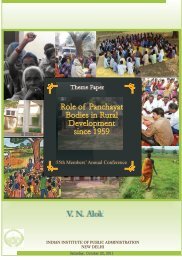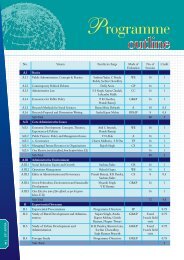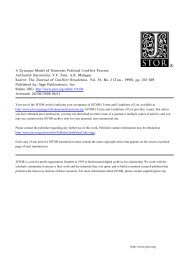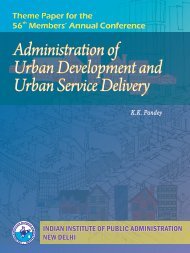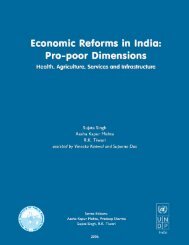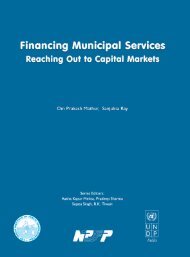India's Telecom Reform - Indian Institute of Public Administration
India's Telecom Reform - Indian Institute of Public Administration
India's Telecom Reform - Indian Institute of Public Administration
You also want an ePaper? Increase the reach of your titles
YUMPU automatically turns print PDFs into web optimized ePapers that Google loves.
India’s s <strong>Telecom</strong> <strong>Reform</strong>:<br />
m:<br />
A Chronological Account<br />
Mahesh Uppal with S.K.N. Nair and C.S. Rao 1<br />
1<br />
Introduction<br />
The telecom sector occupies a special area <strong>of</strong> interest for<br />
students and analysts <strong>of</strong> India’s economic reforms, because<br />
<strong>of</strong> the lead role it played in drawing private investment,<br />
the institutional changes that the process involved<br />
and the dramatic results achieved in terms <strong>of</strong> availability<br />
and access. A chronological recording <strong>of</strong> India’s telecom<br />
reforms is invaluable for a complete understanding <strong>of</strong> the<br />
tortuous reforms process and the clash <strong>of</strong> interests among<br />
existing and new participants and mid-course policy corrections.<br />
By end 2003, positive trends resulting from the reforms,<br />
like accelerated growth in penetration levels and fall in tariffs,<br />
were already in evidence (see Tables 1 to 6). The level<br />
<strong>of</strong> telephone penetration, which was less than half <strong>of</strong> one<br />
percent in 1991, had increased to about 4 per 100 <strong>of</strong> population<br />
in terms <strong>of</strong> fixed line phones. (This growth index<br />
has crossed 10, taking both fixed and mobile phone subscribers<br />
into account). However, the sharp increase in subscriber<br />
numbers is concentrated in the urban areas. The<br />
rural subscriber base has grown at a much slower rate as<br />
compared to the urban and seems virtually stagnant when<br />
the two are compared. Thus, while the urban poor have<br />
seen vast improvements – in availability as well as<br />
affordability - the rural populations have seen little <strong>of</strong> the<br />
beneficial effects <strong>of</strong> competition<br />
The Universal Service Obligation Fund – into which telephony<br />
operators pay a universal service levy - was set up<br />
in 2002 to address this urban-rural “digital divide” by providing<br />
subsidies to operators for expanding access to phones<br />
and Internet in rural areas. The Fund has had mixed success<br />
and is largely unutilised, thus highlighting the complexity<br />
<strong>of</strong> running such subsidy schemes. A strong plea to<br />
review its approach has recently been made by the regulator,<br />
who has argued that a more cost effective approach<br />
for the USOF would be to move from its current focus<br />
on fixed telephone lines to fund shared wireless infrastruc-<br />
1<br />
This study was conducted as part <strong>of</strong> the UNDP funded ‘economic reforms’ programme under which the NCAER Centre for Infrastructure and<br />
Regulation has been set up. Dr. Mahesh Uppal authored the main body <strong>of</strong> the report. The chronology and statistical tables accompanying it were<br />
compiled under his supervision. He was assisted by Ms. Ramneet Goswami, Research Associate, NCAER Centre for Infrastructure and Regulation.<br />
The introductory and concluding sections <strong>of</strong> the Report are contributed by S.K.N. Nair, Adviser, NCAER. Ms. Nandini Acharya, Research Associate<br />
assisted with data and verification. The note on ‘Information Communication Technology and Poverty Alleviation’ in Appendix II was written by Dr.<br />
Ch. Sambasiva Rao, Associate Fellow, NCAER. The views expressed in this paper are those <strong>of</strong> the authors and do not necessarily reflect the views<br />
<strong>of</strong> GOI, UNDP or IIPA.<br />
1


